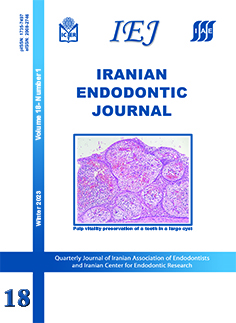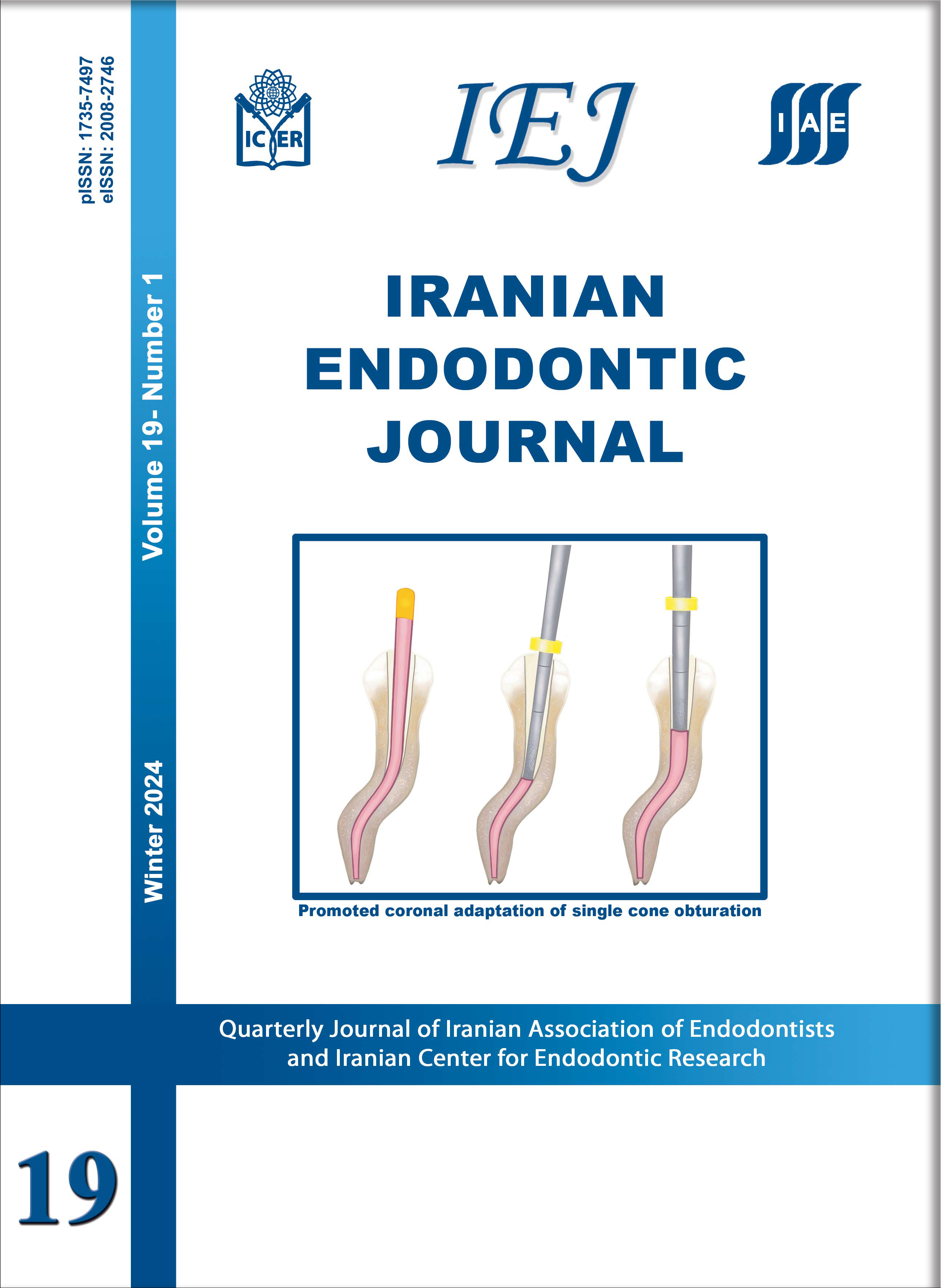Assessment of Dentinal Tubules Penetration by Hyben X Delivered into the Root Canal System as an Irrigant; An in Vitro Study
Iranian Endodontic Journal,
Vol. 18 No. 1 (2023),
17 January 2023
,
Page 53-58
https://doi.org/10.22037/iej.v18i1.33114
Abstract
Introduction: Disinfection of the root canal system is crucial for a successful endodontic treatment. Several factors influence the performance of effective irrigation. Diverse irrigating substances have been used but none has proved to completely penetrate the root canal system. HybenX dries biofilm due to its hygroscopic properties; therefore, it is effective in the treatment of biofilm-related diseases. This investigation aimed to estimate HybenX’s degree of penetration into the dentinal tubules of upper first premolars. Materials and Methods: Experimental in vitro intervention where 30 extracted maxillary premolars were evaluated to determine HybenX’s degree of penetration and 5% sodium hypochlorite in the dentinal tubules using three different irrigation techniques (passive ultrasonic irrigation, dynamic manual irrigation and conventional single jet irrigation technique). After preparation, the root canals were irrigated with fluorescent rhodamine 6G; then 500-micrometer sections were made to be analyzed under a fluorescence microscope. Measurements were made in micrometer in ZEN software to determine the penetration degree of each substance in the different root thirds. Results: In the apical third, significant differences between the 3 irrigation techniques were found (P<0.05), similarly, for the middle and cervical thirds. Significant statistical differences between the HybenX and sodium hypochlorite were found at the cervical and middle levels when using the conventional Monoject irrigation and passive ultrasonic irrigation techniques. As for the apical level, differences were found between the passive ultrasonic irrigation techniques and the dynamic manual irrigation technique. Conclusions: Based on this in vitro study, HybenX proved to highly penetrate into the dentinal tubules, especially when using the passive ultrasonic irrigation technique. HybenX may be a useful option for root canal irrigation in endodontics.
- Biofilms; Hybenx; Root Canal Irrigants; Root Canal Preparation
How to Cite
References
2. Ordinola-Zapata R, Bramante CM, Garcia RB, de Andrade FB, Bernardineli N, de Moraes IG, et al. The antimicrobial effect of new and conventional endodontic irrigants on intra-orally infected dentin. Acta Odontol Scand. 2013 Jul;71(3–4):424–31.
3. Yilmaz A, Yalcin TY, Helvacioglu-Yigit D. Effectiveness of Various Final Irrigation Techniques on Sealer Penetration in Curved Roots: A Confocal Laser Scanning Microscopy Study. BioMed Res Int. 2020;2020:8060489.
4. Dioguardi M, Gioia GD, Illuzzi G, Laneve E, Cocco A, Troiano G. Endodontic irrigants: Different methods to improve efficacy and related problems. Eur J Dent. 2018 Sep;12(3):459–66.
5. Vineet A, Rajesh M, Sonali K, Mukesh P. A Contemporary Overview of Endodontic Irrigants – A Review. Austin J Dent Appl. 2014 Oct 24;1:105–15.
6. Mohmmed SA, Vianna ME, Penny MR, Hilton ST, Knowles JC. The effect of sodium hypochlorite concentration and irrigation needle extension on biofilm removal from a simulated root canal model. Aust Endod J J Aust Soc Endodontology Inc. 2017 Dec;43(3):102–9.
7. Guerreiro-Tanomaru JM, Loiola LE, Morgental RD, Leonardo R de T, Tanomaru-Filho M. Efficacy of four irrigation needles in cleaning the apical third of root canals. Braz Dent J. 2013;24(1):21–4.
8. Mozo S, Llena C, Forner L. Review of ultrasonic irrigation in endodontics: increasing action of irrigating solutions. Med Oral Patol Oral Cirugia Bucal. 2012 May 1;17(3):e512-516.
9. Arias-Moliz MT, Ruiz-Linares M, Ferrer-Luque CM. Irrigating solutions in root canal treatment. ENDO EPT. 2019;13(2):131–46.
10. Zou L, Shen Y, Li W, Haapasalo M. Penetration of sodium hypochlorite into dentin. J Endod. 2010 May;36(5):793–6.
11. Antonelli A, Giovannini L, Baccani I, Giuliani V, Pace R, Rossolini GM. In Vitro Antimicrobial Activity of the Decontaminant HybenX® Compared to Chlorhexidine and Sodium Hypochlorite against Common Bacterial and Yeast Pathogens. Antibiot Basel Switz. 2019 Oct 17;8(4).
12. Ye W-H, Fan B, Purcell W, Meghil MM, Cutler CW, Bergeron BE, et al. Anti-biofilm efficacy of root canal irrigants against in-situ Enterococcus faecalis biofilms in root canals, isthmuses and dentinal tubules. J Dent. 2018;79:68–76.
13. Levrini L, Paracchini L, Nosotti MG. The Capacity of Periodontal Gel to Occupy the Spaces Inside the Periodontal Pockets Using Computational Fluid Dynamic. Dent J. 2019 Dec 24;8(1):1.
14. Edgar NR, Saleh D, Miller RA. Recurrent Aphthous Stomatitis: A Review. J Clin Aesthetic Dermatol. 2017 Mar;10(3):26–36.
15. Nardi GM, Grassi FR, Lauritano D, Petruzzi M. An Alternative Approach for the Treatment of Major Aphthosis: Case Report. JBR J Interdiscip Med Dent Sci. 2014 Aug 11;2(5):1–3.
16. Lauritano D, Girardi A, Carinci F. The efficacy of hybenx ® oral tissue decontaminant for periodontal disease treatment : a case series study. Int J Adv Case Rep. 2015 Jan 2;2(7):405–8.
17. Lopez MA, Andreasi Bassi M, Confalone L, Silvestre F, Arcuri C. The treatment of peri-implant diseases: a new approach using hybenx® as a decontaminant for implant surface and oral tissues. ORAL Implantol. 2016 Sep;9(3):106–14.
18. Pace R, Di Nasso L, Tauro L, Nizzardo A, Pagavino G, Giuliani V. Analysis of dentinal erosion and removing smear layer of different irrigation protocols: an in vitro study. G Ital Endodonzia [Internet]. 2020 Oct 26 [cited 2020 Nov 11];34(2). Available from: https://doi.org/10.32067/GIE.2020.34.02.17
19. Pini-Prato G, Magnani C, Rotundo R. Treatment of Acute Periodontal Abscesses Using the Biofilm Decontamination Approach: A Case Report Study. Int J Periodontics Restorative Dent. 2016 Feb;36(1):55–63.
20. Porter SR, Al-Johani K, Fedele S, Moles DR. Randomised controlled trial of the efficacy of HybenX in the symptomatic treatment of recurrent aphthous stomatitis. Oral Dis. 2009 Mar;15(2):155–61.
21. Galler KM, Grubmüller V, Schlichting R, Widbiller M, Eidt A, Schuller C, et al. Penetration depth of irrigants into root dentine after sonic, ultrasonic and photoacoustic activation. Int Endod J. 2019 Aug;52(8):1210–7.
22. Christopher SR, Mathai V, Nair RS, Angelo JMC. The effect of three different antioxidants on the dentinal tubular penetration of Resilon and Real Seal SE on sodium hypochlorite-treated root canal dentin: An in vitro study. J Conserv Dent JCD. 2016 Apr;19(2):161–5.
23. DENTAL SUPPLEMENT, Pace R, Di Nasso L, Nizzardo A, Tauro L, Pagavino G, et al. The effects of a new decontaminant solution on root canal bleeding during endodontic treatment: a randomized controlled study. J Biol Regul Homeost Agents. 2019 Jun;33(3 Suppl. 1):1–9.
24. Ballal V, Khandelwal D, Yegneswaran PP, Varghese J, Al-Haj Husain N, Özcan M. Evaluation of Smear Layer Removal and Antimicrobial Efficacy of HybenX Against Enterococcus Faecalis Biofilm. Eur J Prosthodont Restor Dent. 2020 Jul 31;
- Abstract Viewed: 333 times
- PDF Downloaded: 231 times




